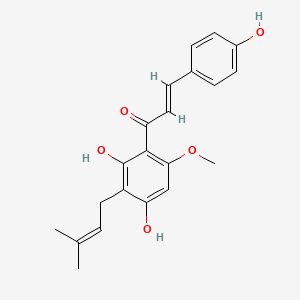Possible associated with:
| Structure | name | description | Reference count |
|---|---|---|---|

|
butyric acid | butyric acid is a lipid of Fatty Acyls (FA) class. Butyric acid is associated with abnormalities such as PARKINSON DISEASE, LATE-ONSET, Colitis, Autoimmune Diseases, Inflammatory Bowel Diseases and PARAGANGLIOMAS 2. The involved functions are known as DNA Methylation, Transcription, Genetic, chromatin modification, Gene Expression and Gene Silencing. Butyric acid often locates in Membrane, Chromatin Structure, Chromosomes, viral nucleocapsid location and Ribosomes. The associated genes with butyric acid are Locus, Genes, Dominant, Genes, rRNA, Genome and Chromatin. The related lipids are Butyrates, butyrate, Promega, Butyric Acids and Butyric Acid. | 9358 |

|
(r)-3-hydroxybutanoic acid | (r)-3-hydroxybutanoic acid is a lipid of Fatty Acyls (FA) class. | 2710 |

|
trichostatin A | Trichostatin is a lipid of Polyketides (PK) class. Trichostatin is associated with abnormalities such as Dentatorubral-Pallidoluysian Atrophy, PARAGANGLIOMAS 3, abnormal fragmented structure, Disintegration (morphologic abnormality) and Hyperostosis, Diffuse Idiopathic Skeletal. The involved functions are known as Acetylation, Cell Differentiation process, histone modification, Gene Silencing and Transcriptional Activation. Trichostatin often locates in CD41a, Hematopoietic System, Chromatin Structure, Blood and Endothelium. The associated genes with Trichostatin are SPI1 gene, CELL Gene, Chromatin, CXCR4 gene and DNMT1 gene. The related lipids are Butyrates, Promega, butyrate, Lipopolysaccharides and Steroids. The related experimental models are Knock-out, Mouse Model, Xenograft Model and Cancer Model. | 5401 |

|
(-)-Epigallocatechin gallate | (-)-Epigallocatechin gallate is a lipid of Polyketides (PK) class. (-)-epigallocatechin gallate is associated with abnormalities such as IMMUNE SUPPRESSION, Infection, Nodule, Lymphopenia and Tumor Immunity. The involved functions are known as Apoptosis, Cellular Immune Response, Specific immune response, Signal and Infiltration. (-)-epigallocatechin gallate often locates in Immune system, Cytoplasmic Granules, Skin, Protoplasm and Body tissue. The associated genes with (-)-Epigallocatechin gallate are C8orf4 gene, Genes, vpr, MAPK8 gene, P4HTM gene and GAG Gene. The related lipids are Promega, Lipopolysaccharides, Palmitates, Fatty Acids and Sphingolipids. The related experimental models are Mouse Model, Xenograft Model, Transgenic Model, Experimental Autoimmune Encephalomyelitis and Arthritis, Collagen-Induced. | 6551 |

|
apigenin | apigenin is a lipid of Polyketides (PK) class. Apigenin is associated with abnormalities such as Morphologically altered structure, Chimera disorder, Hypertensive disease, infection induced and Infection. The involved functions are known as inhibitors, Gene Expression, Process, Metabolic Inhibition and Cell Death. Apigenin often locates in Vacuole, Cytoplasmic matrix, Cytoplasm, Tissue membrane and Membrane. The associated genes with apigenin are MSMP gene, BCL2 gene, PTGS2 gene, Chromatin and SLC33A1 gene. The related lipids are Lipopolysaccharides, Steroids, 1-Butanol, agosterol A and Butyrates. The related experimental models are Mouse Model, Tissue Model, Knock-out, Xenograft Model and Disease model. | 4250 |

|
baicalein | baicalein is a lipid of Polyketides (PK) class. Baicalein is associated with abnormalities such as Neurodegenerative Disorders, Fibrillation, Hypertensive disease, Aortic coarctation and Coronary Occlusion. The involved functions are known as Anabolism, Polymerization, Process, inhibitors and Pathogenesis. Baicalein often locates in Membrane, Lipid Bilayers, soluble, Cell-Free System and Protoplasm. The associated genes with baicalein are P4HTM gene, BIRC5 gene, TSPO gene, SHOC2 gene and XIAP gene. The related lipids are Fatty Acids, Nonesterified Fatty Acids, iodoresiniferatoxin, Lipopolysaccharides and 17-octadecynoic acid. The related experimental models are Knock-out, Mouse Model and Parkinsonism, Experimental. | 1997 |

|
Xanthohumol | Xanthohumol is a lipid of Polyketides (PK) class. Xanthohumol is associated with abnormalities such as Endometriosis, site unspecified, Cyst, peritoneal lesion, Proliferative inflammation and furuncle. The involved functions are known as Cell Proliferation, Signal Transduction, Pathologic Neovascularization, Adverse effects and Proliferation (morphologic abnormality). Xanthohumol often locates in peritoneal, Mesentery, Membrane, Tissue specimen from uterus and Cell Nucleus. The associated genes with Xanthohumol are PI3 gene, KEAP1 gene, SLC33A1 gene, BCR-ABL Fusion Gene and BIRC5 gene. The related lipids are Fatty Acids and Palmitates. The related experimental models are Knock-out. | 465 |
Total
7